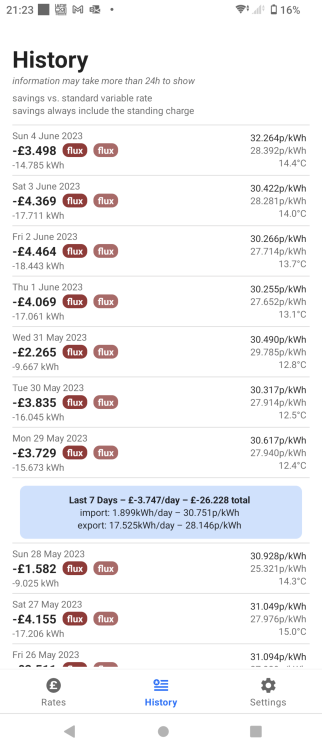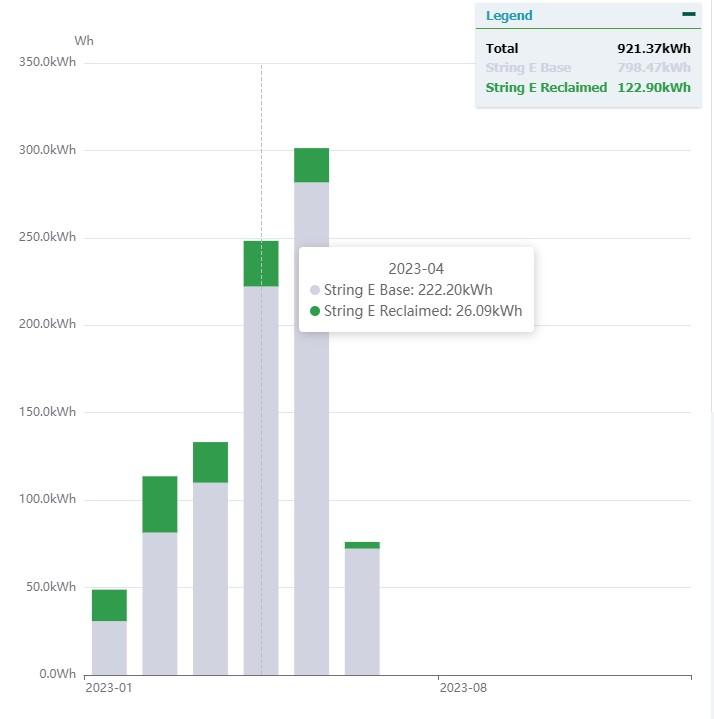Leaderboard
Popular Content
Showing content with the highest reputation on 06/13/23 in all areas
-
Plan to have a play and find the sweet spot. Hoping the solar will mean very little is needed from the ASHP apart from deep winter.3 points
-
Only you know the value of optimisers as only you know the annoyance of not generating at max. For pure ROI it can vary massively. If you buy at retail prices and pay someone to fit them you may never get your money back if shading is only causing a small loss. On the other hand if youre not in a rush and wait for optimisers to come up on ebay you can buy them at a fraction of the retail price. If you fit them yourself, which is straight forward, then you make more of a saving. Optimisers give you individual panel monitoring so you can see at a glance if and where youve got a problem. I've just moved 4 panels that had partial shading but it was only the individual monitoring that showed how much they were being impacted by a nearby chimney How to quantify "shading" losses is near impossible to determine as shading comes in so many forms- trees, structures, algal growth, dust, clouds, bird s**t etc. Picking them up off eBay and self installing makes it worth while for me, but that might not be the case for you, only you know how you value things!3 points
-
I done know @Dave Jones First, i dont have to have that bloody huge push plate right behind the lift up toilet seat. I tend to have a small button off to the side. I usually do the shelf in either Marble, Granite, or a manufactured stone. This provides a useful space for my expensive (Hugo Boss, etc) reed diffuser.2 points
-
Depends if you need a good shelf and how it fits in with the rest of the room....2 points
-
very very bad year for pollen, my eldest is really struggling. the hepa+uv filter on the mvhr will be a godsend.2 points
-
ASHP , big uvc My let property has 4 showers - I made certain all could run simultaneously for 10 minutes . Uvc not gas ‘boosted ‘ - purely electric . If you get issues ( I actually had 5 showers ) you can get a shower that feeds directly off a cold header tank .2 points
-
Well - this ignores some things . You could end up exporting at 35p a kw - like I do . I estimate I’ll earn £1000 a year from that . What no one seems to understand ( I do - I got a pw in 2020 and was mocked on here for ‘ a waste of money ‘ etc ) . Electric consumption is meant to double over the next few decades . Price will vary of course but ‘cheap’ days are gone ( bit like boe rate ) . Also when you have a battery you naturally are more ‘aware’ of usage e.g turn the (expletive deleted)ing light off . My ROI ( EV 4000 miles per year aswell ) is around 6/7 years at this point in time . If roi is everything then don’t do it . What do people want ? A return in 2 or 3 years ? . Yet buy a 300k house , mortgage for 25yrs and ultimately have bought it for a million quid ….. New Tesla for 80k , roi ? That nice holiday ; roi never What’s important to 1 person isn’t the same for everyone . I could just (expletive deleted) it have no battery , pv , EV and go on another holiday . Next generation can deal with it “ not my problem “. That view is what governments largely do hence issues with nhs / housing etc. Etc.2 points
-
A lot of people store hot water at around 48C, but there is no you can't store water at up to 60C if you have R290 ASHP. It's a trade-off between COP and the heat losses from UVC (reasons to use lower temp) vs. more hot water for showers (reason to use higher temperature). A 300L tank at 48C will give you 360L of shower water, whereas the same tank at 60C will give you 420L of "shower water" at 40C. How many showers this gives you, will depend on how long you shower for and your design flow rate, but assuming a 12min shower (@ 12L/min), that's between 2.5 and 3 showers. An ASHP recovers more slowly though, so (assuming ASHP is shared with heating and you don't oversize it) it will take an hour or more to recover (although there are some approaches using PHEs which try to work around this). You can also get another 30%+ from your stored water by using WWHRS. I don't think there is really anything you can do with gas that you can't do with ASHP (aside from the very fast reheat time), it is really about being clear on what your requirements are and designing for this. What is your design shower flow rate, how long are showers? Maximum parallel/consecutive showers?2 points
-
Are we wasting our time when middle America still drives gas guzzling cars, still use their tumble driers on hot sunny days (the neighbours would complain if I hang washing outside - only trailer trash do that), put the heating on and then clear off to Florida for the winter to avoid the sub zero climate they live in, nip outside to start the gas guzzler half an hour before a journey so that the air con has made the car comfortable even though it is parked in the communal garage that is also heated and air cooled!2 points
-
I guess the old poor housing stock issue could be tackled another way. If you really can change all our electricity generation to carbon neutral, and provide lots of it, then perhaps the thinking is, it does not matter if old houses use a lot of energy to heat them, as long as it really is carbon neutral generated energy.2 points
-
I'd recommend a Makita set a blue box at about £20. They are so⁸ good that peiple"borrow" bits and hence I have 3 partial sets.2 points
-
Hi, As a small step towards repaying the valuable advice I have received on this forum I thought I'd share the attached document, which I hope will be useful and/or interesting to forum users. I am a planner by trade, working in local authority. My SB is on a relatively small, highly inaccessible plot neighboured by mature trees, and tightly bordered by existing houses. The plot was a 'detached' back garden of sorts that came as part of the deal (and something of an afterthought) when we bought our current house. Nobody had ever even considered the prospect that it could be a building plot, and for many years I discounted the idea myself due to the restrictions listed above. Five years ago, having outgrown our house and exhausted other options, I decided to at least try to self build on the plot. I obtained permission at the first time of asking (albeit not quickly and not without having to make a tweak or two). Everyone, without exception, from family to neighbours to building tradesmen to delivery drivers to other planners, have commented on how 'well' I've done to get permission. Some of them probably thought I'd made a mistake, or that the Council did, or that there was some old pals act involved because I am a planner myself (even though I don't work in the borough where I am building, and it really, really doesn't work that way anyway). They are all wrong. I obtained permission because I did the thing that planners spend their working lives telling others to do - I read the relevant planning policies, designed a development that was in line with them, then demonstrated as much in the application. That is what the attached statement does, it goes from global to national to regional to local policy, then explains the thought process behind my design, in that context. I cannot tell you how many architects, developers and would-be planning consultants fail to design development proposals specifically to meet planning policies, and then spend ages moaning, appealing, resubmitting, and generally wasting time. I can't promise that if you follow the thought process in my document you'll certainly get planning permission, but I hope you find it a useful insight into how a planner approached self-build, and specifically the matter of seeking planning permission on a plot that the rest of the world had discounted. Cheers 647910914_DesignandAccessStatementRedacted.pdf1 point
-
1 point
-
Yes it did then. The tops are very occasional times when I was doing two jobs and was bathing 3 times a day, and E7 can be switched on briefly for gird balancing, but not so much these days, if at all. The chart shows hourly mean. My energy plot is for the whole house though. It is a worth while exercise. I stopped monitoring because I was not learning any more about my water energy usage, using less in he winter saves me more. Last year and so far this year, I have cut my usage by 40 lt a day (we are in serious draught down here). As 2/3rd of that is hot water, there is an energy saving of around 0.6 kWh/day.1 point
-
That’s worrying Will need knocking off and the brickwork spraying with a salt inhibitor1 point
-
1 point
-
1 point
-
Sounds reasonable. Our 150L Range Tribune UVC (fairly run of the mill I think? 15 years old now though) has a purported standing heat loss of 1.31 kWh/24hrs (no stored/ambient temperatures stated - is this standardised?1) so converting that into °C heat loss: Convert from Watts to Joules: 1.31 kWh x 3.6 MJ/kWh = 4.716 MJ Convert to °C based on the heat capacity of the specified quantity of water: 4.716 MJ * 1000000 / (150000 mL x 4.2 J/ml) = 7.5 °C Given the variability of installation the published figure might well only include the cylinder itself and not any connected pipework thus it would lose more in real life. Stratification may also lead to slightly different results depending on where the probe is too I think. 1 Edit: Yes, it looks like the various related British Standards specify a stored water temperature of 70°C and an ambient room temperature of 20°C for standing heat loss measurements. Thus, your 48°C starting point may or may not have more significance than I have given consideration for.1 point
-
Fit Geberit or Grohe. Everything else is crap. All the Geberit drawings are on their site. With Geberit it's all serviceable through the flush plate. https://www.geberit.co.uk/products/bathroom-products/concealed-cisterns/1 point
-
1 point
-
I never understood why anyone would want drawings on site - builders never read them anyway!!!😂😂😂😂.1 point
-
0.5C per hour? Assuming no one has used the hot water? I'm not sure that's great actually - I'm getting about that for a badly insulated thing from 30-years ago. Interesting data though. In a real-life case, I wonder how much is heat loss and how much is just mixing with the incoming cold water. Actually I'm interested if anyone else has data - as I had on my to do list to replace the cylinder here with something more modern with 'better insulation'.1 point
-
But very good at knocking that on the head right at that location.1 point
-
You can get them, uses the refrigeration circuit waste heat to heat the cylinder.1 point
-
There are such things as slow blow fuses, designed to deal with start up spikes, is there any chance you need one of these?1 point
-
Look at the following brands for high-quality screwdriver sets. https://www-uk.wera.de/en https://www.wiha.com/gb/en/ The challenge is working out which set makes the most sense..!1 point
-
maybe there is a double ashp so in cooling mode it can shed the heat into the other pump to blast the dhw.1 point
-
I looked at all the online help on swales and rain gardens - here - for example. The images are of more help than the text. Our roof faces North and South. The North face drains to a rain garden (in construction still : old plasterers bath, reeds and a bit of plumbing) and the overflow from that - via a sand filter bed - into an attenuation pond. The overflow from that goes then to the pond - itself built on an existing spring. I discovered the spring by getting our digger stuck on (in) it. The process of digging ourselves out of the area showed that the hole dug continually refilled itself. The attenuation pond has overflowed once in three years The rain from the North face is ducted straight to the pond (via another raingarden) with the 110 pipe hidden artfully with stones. That provides most water for the pond . Every time it rains, all the water goes into the pond. The pond itself overflows into some of our lower garden: an Alder and an unknown tree (beautiful red papery bark) loves it. Cost? 50 meters of 110 pipe, digger for 2 days, two plasterer's 'baths', odds and sods of piping and some cladding to hide the raingarden holder. Shown with pride to the BCO: who could not have been less interested.1 point
-
1 point
-
they dont need it, limitless virtually free natural gas (waste product of their massive oil reserves).1 point
-
As others have said, it's highly unlikely to be worth while in terms of energy saved. There are optimisers on 32 of our 54 panels. Most don't do much, one set does. One string of 6 panels facing SE has shading on the bottom 3 panels from trees in the morning. I put optimsers on those panels and there is virtually no reclaimed energy Garage has 12 panels on one side with optimisers on 9 panels and shading in the morning and also doesn't recover much energy. The other side of the garage roof has more significant shading and optimisers on every panel. That recovers more energy, but it's not an amazing amount. There are also 8 panels on a shed which face 3 different directions and have significant shading throughout the day. These do recover a noticeable amount of energy. Conclusion, it isn't worth it financially, but for me it is for the monitoring.1 point
-
have exactly the same issue with our current build. 5 beds / 4 baths. Current plan is an accumulator to maintain cold pressure and starting with 2 x 300L tanks with space to add more. I'll keep adding them until we dont run out of hot. Heating the water, will use ASHP to get it 45ish then overnight immersion to get it as hot as safely possible. Solar PV dump when available etc.1 point
-
I know . All the great men in history were mocked . Only after their demise was their ground breaking radical excellence acknowledged.1 point
-
Not sure you really need that, you will have got fed up waiting for the shower run hot by the time water got there. 15mm is fine, maybe a dedicated 15mm to each wet room from a manifold close to the cylinder may be more practical. That what we did and the showers flow plenty. I completed my build i.e. had council sign off a few months ago. I fitted a gas combi with preheat cylinder during the build. Since sign off, I have installed an ASHP. The fact is with UFH and well insulated an ASHP is/should be cheaper to run for 98-99% of the year compared to gas. With PV you get to offset some of the running cost. In summer your hot water should be free. Even if your PV is only generating 1kW you are filling the cylinder with 3 to 4 kW by using your ASHP. Will use the ASHP in the summer for hot water and use the nearly new gas one in the winter. You need to shop around for PV your prices are huge. I picked up 12x285W, 2 year old panels yesterday for £800, picked up the nearly new inverter for £150, ground mount frame will be about £300 in materials, plus a load of 6mm2 armoured cable.1 point
-
You can buy a dual Tigo which does 2 panels with one device.1 point
-
I won an impact driver, so otherwise wouldn't have one. Seldom used. I think maybe it is for use under the car,more than for building1 point
-
I listened to a solar entrepreneur in an interview the other day. He said that governments are just too slow so as a business they're just getting on with it without them. He's involved in a load of projects around the world including large scale projects in Africa.1 point
-
Let's say you use an average of 3 kW for 3 hours, 9 kWh or at 50p/kWh £4.5/day. £1650/year. Now you will need a 10 kWh system, plus the price of charging it up. Say you can get a system that will last a decade, so £1000/year plus the charging cost of £525. So you save £75/year, or £1.45/day. Thing is, you probably only use a couple if kWh a day cooking, and not every day as well. At the moment we have volatile energy prices, and declining energy storage prices. How would you feel if you could buy in power at below 20p/kWh any time of day or night, and storage cost £120/kWh. There are easier ways to save a quid and a half.1 point
-
I am in a similar position, have just bought 12 panels, I will be splitting into 2x6 arrays. I did concider optimiser, and rejected them, due little or no shade except clouds. I do have them on my roof array, but that gets a fair bit of shading.1 point
-
Not much power in a low sun, especially if your modules are at around 30⁰. You may find optimisers increase overall output by 2% of very little.1 point
-
If you use liquid foam in the cavity, you will be limited to breathable only products on the external insulation, wood fibre, rockwool etc, you won't be able to use EPS or Phenolic, something to bear in mind1 point
-
It doesn't need to be superior metal, as long as it works. BG spend a lot on marketing and research which must increase the cost. Also they get specified by Architects so can charge more. The specialist merchants usually stock the big names and a cheaper option. It must be OK......I have specifically asked a manager and was told the cheaper one was fine, but most specifiers don't even know it exists. It's not complicated...buy galvanised strip, Bend it.1 point
-
The gaps between the woodcrete are too big to support capillary action. Put some woodcrete in a bucket with some of the block out of the water. The part out of the water stays dry. Been there tried it. And is fully free draining. But whatever you want to say, carry on, will not be following this thread any more.1 point
-
https://www.kore-system.com/insulation-series-using-eps-for-cavity-wall-insulation-applications/1 point
-
If you're using a beam and block floor I'd increase the screed to 75m as the beams are prestressed creating a camber as much as 25mm at midspan, this will vary depending what infill blocks are used and finishes. My opinion not advice1 point
-
1 point
-
@MortarThePoint Apologies for late reply. My observations on Full Fill Bonded blown Beads, Are they Full Fill: Yes very much so, in our wide cavity at least. I drilled a few trial holes around windows and doors to check in awkward to reach places. All full with beads. Are they Bonded: Kinda, a little hit and miss really as i found out when coring ventilation holes and lost a few buckets. The remaining question: Will they settle.......? Time will tell. Would I use them again? Yes, but I would core all holes in the wall first.1 point
-
We've had a 250mm Cavity done this week with blown eps bead. I climbed into the attic earlier to have a look as I was sceptical the beads would fill right up to our cavity closer (450mm DPC). I checked the entire perimeter of the house and was pleased to find the beads had billowed up the DPC everywhere. Its given me confidence that around the windows and doors there's a tight fill as well. I may do some trial holes if I can find the time but thus far I'm more impressed than I thought I'd be.1 point
-
I went full fill batts but 300mm wide cavity. No way would I let brickies install it, I did it all myself. They did try to fit some but I took it out and re did it. beads are great but I think you will find they work out too expensive. If you do for them go for platinum ones.1 point
-
Did a 150mm cavity with blown bead and worked really well - they got everywhere ..! They set after about 3 hours as they are glued together when installed and I’ve core drilled sections through so know that they don’t really move about much once installed. I’d use them again over batts which are a pain as they are bulky and get in the way. I’ve also seen batts get soaked on site and still used - they are not cheap to chuck in a skip.1 point
This leaderboard is set to London/GMT+01:00
















